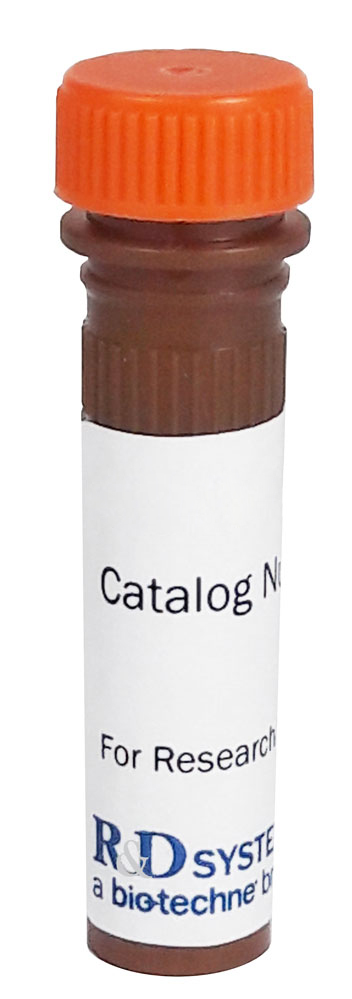Mouse LAP (TGF-beta 1) Alexa Fluor® 647-conjugated Antibody Summary
Met1-Ser390
Accession # P04202
Applications
Please Note: Optimal dilutions should be determined by each laboratory for each application. General Protocols are available in the Technical Information section on our website.
Reconstitution Calculator
Preparation and Storage
- 12 months from date of receipt, 2 to 8 °C as supplied.
Background: LAP (TGF-beta 1)
TGF-beta 1 (Transforming Growth Factor beta 1) is one of three closely related mammalian members of the large TGF-beta superfamily that share a characteristic cystine knot structure (1‑7). TGF-beta 1, -2 and -3 are highly pleiotropic cytokines that are proposed to act as cellular switches that regulate processes such as immune function, proliferation and epithelial-mesenchymal transition (1‑4). Each TGF-beta isoform has some non‑redundant functions; for TGF-beta 1, mice with targeted deletion show defects in hematopoiesis and endothelial differentiation, and die of overwhelming inflammation (2). Human TGF‑ beta 1 cDNA encodes a 390 amino acid (aa) precursor that contains a 29 aa signal peptide and a 361 aa proprotein (8). A furin‑like convertase processes the proprotein to generate an N‑terminal 249 aa Latency‑Associated Peptide (LAP) and a C‑terminal 112 aa mature TGF‑ beta 1 (8, 9). Disulfide‑linked homodimers of LAP and TGF‑ beta 1 remain non‑covalently associated after secretion, forming the small latent TGF‑ beta 1 complex (8‑10). Covalent linkage of LAP to one of three latent TGF‑ beta binding proteins (LTBPs) creates a large latent complex that may interact with the extracellular matrix (9, 10). TGF‑ beta is activated from latency by pathways that include actions of the protease plasmin, matrix metalloproteases, thrombospondin 1 and a subset of integrins (10). Mature human TGF‑ beta 1 shares 100% aa identity with pig, dog and cow TGF‑ beta 1, and 99% aa identity with mouse, rat and horse TGF‑ beta 1. It demonstrates cross‑species activity (1). TGF‑ beta 1 signaling begins with high‑affinity binding to a type II ser/thr kinase receptor termed TGF‑ beta RII. This receptor then phosphorylates and activates a second ser/thr kinase receptor, TGF‑ beta RI, also known as Activin Receptor‑Like Kinase 5(ALK‑5), or alternatively, ALK‑1. This complex phosphorylates and activates Smad proteins that regulate transcription (3, 11, 12). Contributions of the accessory receptors Betaglycan (also known as TGF‑ beta RIII) and Endoglin, or use of Smad‑independent signaling pathways, allow for disparate actions observed in response to TGF‑ beta in different contexts (11).
- Derynck, R. and K. Miyazono (2008) Cold Spring Harbor Laboratory Press, 29.
- Dunker, N. and K. Krieglstein (2000) Eur. J. Biochem. 267:6982.
- Wahl, S.M. (2006) Immunol. Rev. 213:213.
- Chang, H. et al. (2002) Endocr. Rev. 23:787.
- Lin, J.S. et al. (2006) Reproduction 132:179.
- Hinck, A.P. et al. (1996) Biochemistry 35:8517.
- Mittl, P.R.E. et al. (1996) Protein Sci. 5:1261.
- Derynck, R. et al. (1985) Nature 316:701.
- Miyazono, K. et al. (1988) J. Biol. Chem. 263:6407.
- Oklu, R. and R. Hesketh (2000) Biochem. J. 352:601.
- de Caestecker, M. et al. (2004) Cytokine Growth Factor Rev. 15:1.
- Zuniga, J.E. et al. (2005) J. Mol. Biol. 354:1052.
Product Datasheets
Product Specific Notices
This product is provided under an agreement between Life Technologies Corporation and R&D Systems, Inc, and the manufacture, use, sale or import of this product is subject to one or more US patents and corresponding non-US equivalents, owned by Life Technologies Corporation and its affiliates. The purchase of this product conveys to the buyer the non-transferable right to use the purchased amount of the product and components of the product only in research conducted by the buyer (whether the buyer is an academic or for-profit entity). The sale of this product is expressly conditioned on the buyer not using the product or its components (1) in manufacturing; (2) to provide a service, information, or data to an unaffiliated third party for payment; (3) for therapeutic, diagnostic or prophylactic purposes; (4) to resell, sell, or otherwise transfer this product or its components to any third party, or for any other commercial purpose. Life Technologies Corporation will not assert a claim against the buyer of the infringement of the above patents based on the manufacture, use or sale of a commercial product developed in research by the buyer in which this product or its components was employed, provided that neither this product nor any of its components was used in the manufacture of such product. For information on purchasing a license to this product for purposes other than research, contact Life Technologies Corporation, Cell Analysis Business Unit, Business Development, 29851 Willow Creek Road, Eugene, OR 97402, Tel: (541) 465-8300. Fax: (541) 335-0354.
FAQs
No product specific FAQs exist for this product, however you may
View all Antibody FAQsReviews for Mouse LAP (TGF-beta 1) Alexa Fluor® 647-conjugated Antibody
There are currently no reviews for this product. Be the first to review Mouse LAP (TGF-beta 1) Alexa Fluor® 647-conjugated Antibody and earn rewards!
Have you used Mouse LAP (TGF-beta 1) Alexa Fluor® 647-conjugated Antibody?
Submit a review and receive an Amazon gift card.
$25/€18/£15/$25CAN/¥75 Yuan/¥2500 Yen for a review with an image
$10/€7/£6/$10 CAD/¥70 Yuan/¥1110 Yen for a review without an image










